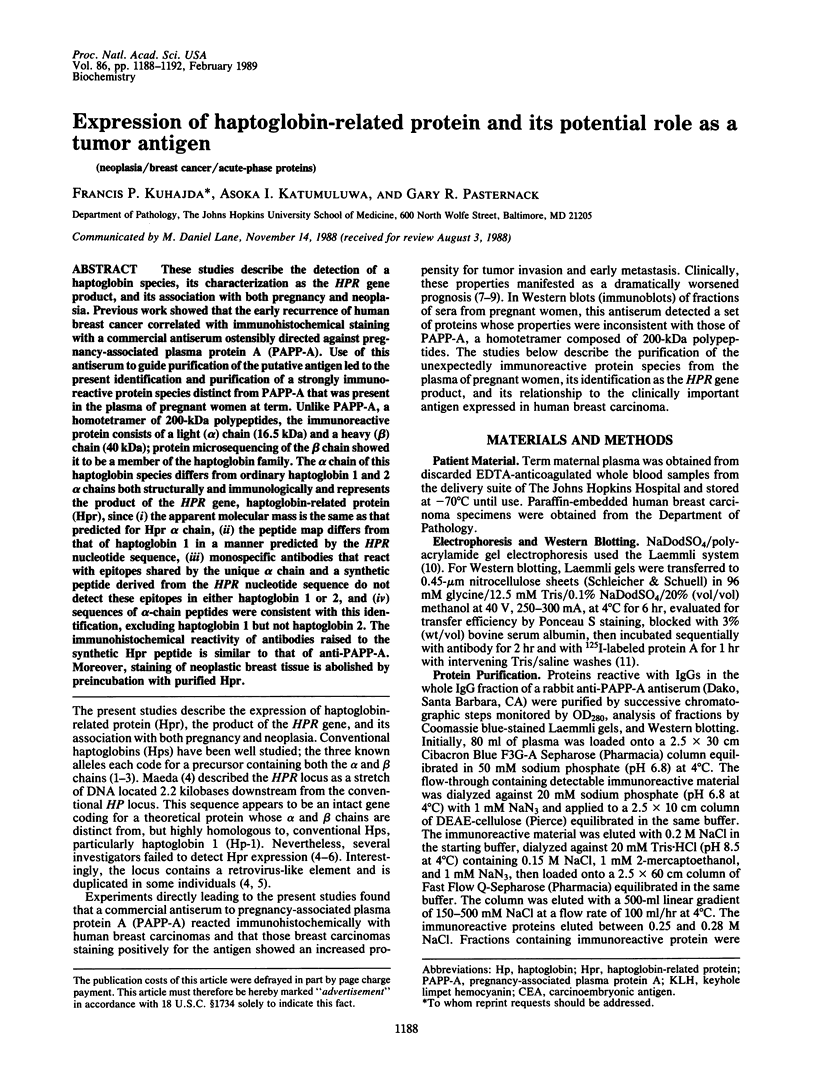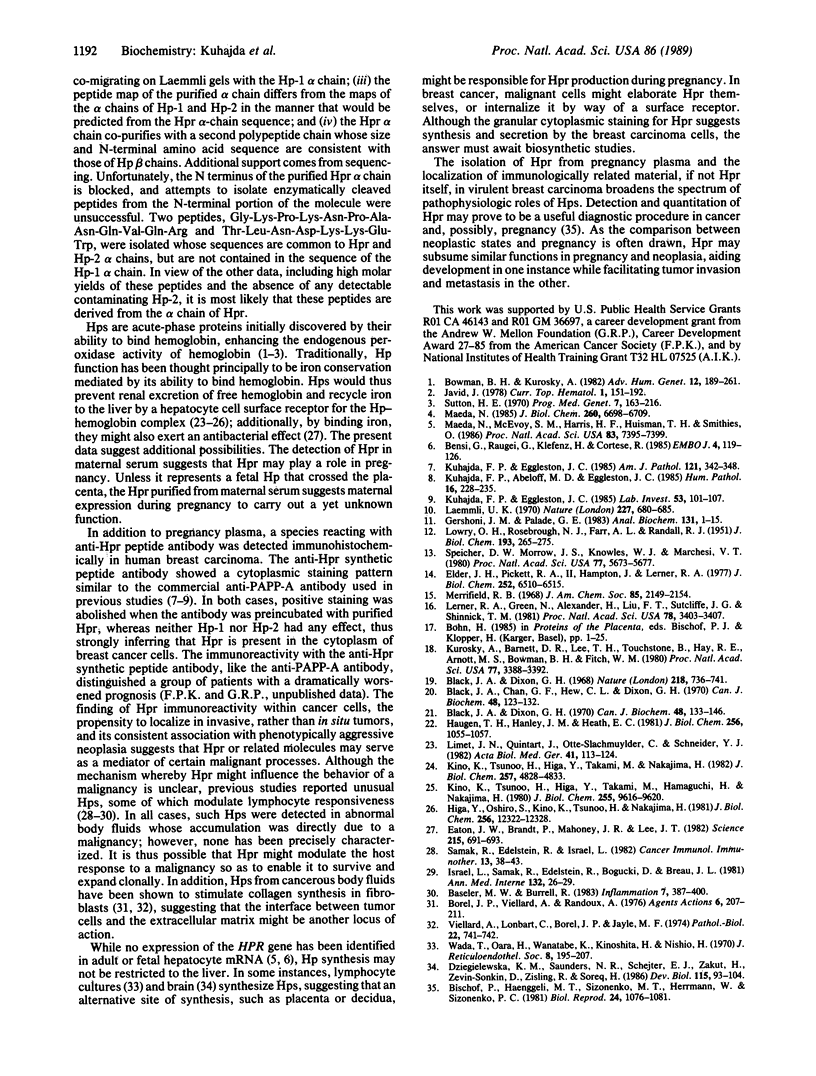Abstract
These studies describe the detection of a haptoglobin species, its characterization as the HPR gene product, and its association with both pregnancy and neoplasia. Previous work showed that the early recurrence of human breast cancer correlated with immunohistochemical staining with a commercial antiserum ostensibly directed against pregnancy-associated plasma protein A (PAPP-A). Use of this antiserum to guide purification of the putative antigen led to the present identification and purification of a strongly immunoreactive protein species distinct from PAPP-A that was present in the plasma of pregnant women at term. Unlike PAPP-A, a homotetramer of 200-kDa polypeptides, the immunoreactive protein consists of a light (alpha) chain (16.5 kDa) and a heavy (beta) chain (40 kDa); protein microsequencing of the beta chain showed it to be a member of the haptoglobin family. The alpha chain of this haptoglobin species differs from ordinary haptoglobin 1 and 2 alpha chains both structurally and immunologically and represents the product of the HPR gene, haptoglobin-related protein (Hpr), since (i) the apparent molecular mass is the same as that predicted for Hpr alpha chain, (ii) the peptide map differs from that of haptoglobin 1 in a manner predicted by the HPR nucleotide sequence, (iii) monospecific antibodies that react with epitopes shared by the unique alpha chain and a synthetic peptide derived from the HPR nucleotide sequence do not detect these epitopes in either haptoglobin 1 or 2, and (iv) sequences of alpha-chain peptides were consistent with this identification, excluding haptoglobin 1 but not haptoglobin 2. The immunohistochemical reactivity of antibodies raised to the synthetic Hpr peptide is similar to that of anti-PAPP-A. Moreover, staining of neoplastic breast tissue is abolished by preincubation with purified Hpr.
Full text
PDF




Images in this article
Selected References
These references are in PubMed. This may not be the complete list of references from this article.
- Baseler M. W., Burrell R. Purification of haptoglobin and its effects on lymphocyte and alveolar macrophage responses. Inflammation. 1983 Dec;7(4):387–400. doi: 10.1007/BF00916303. [DOI] [PubMed] [Google Scholar]
- Bensi G., Raugei G., Klefenz H., Cortese R. Structure and expression of the human haptoglobin locus. EMBO J. 1985 Jan;4(1):119–126. doi: 10.1002/j.1460-2075.1985.tb02325.x. [DOI] [PMC free article] [PubMed] [Google Scholar]
- Bischof P., Haenggeli L., Sizonenko M. T., Herrmann W., Sizonenko P. C. Radioimmunoassay for the measurement of pregnancy-associated plasma protein-A (PAPP-A) in humans. Biol Reprod. 1981 Jun;24(5):1076–1081. doi: 10.1095/biolreprod24.5.1076. [DOI] [PubMed] [Google Scholar]
- Black J. A., Chan G. F., Hew C. L., Dixon G. H. Gene action in the human haptoglobins. 3. Isolation of the alpha-chains as single gene products. Isolation, molecular weight, and amino acid composition of alpha and beta chains. Can J Biochem. 1970 Jan;48(1):123–132. doi: 10.1139/o70-019. [DOI] [PubMed] [Google Scholar]
- Black J. A., Dixon G. H. Amino-acid sequence of alpha chains of human haptoglobins. Nature. 1968 May 25;218(5143):736–741. doi: 10.1038/218736a0. [DOI] [PubMed] [Google Scholar]
- Black J. A., Dixon G. H. Gene action in the human haptoglobins. IV. Amino acid sequence studies on the haptoglobin alpha chains. Can J Biochem. 1970 Jan;48(1):133–146. doi: 10.1139/o70-020. [DOI] [PubMed] [Google Scholar]
- Borel J. P., Viellard A., Randoux A. Effect of some purified plasma proteins on collagen biosynthesis in vitro. Agents Actions. 1976 Feb;6(1-3):207–211. doi: 10.1007/BF01972210. [DOI] [PubMed] [Google Scholar]
- Bowman B. H., Kurosky A. Haptoglobin: the evolutionary product of duplication, unequal crossing over, and point mutation. Adv Hum Genet. 1982;12:189-261, 453-4. doi: 10.1007/978-1-4615-8315-8_3. [DOI] [PubMed] [Google Scholar]
- Dziegielewska K. M., Saunders N. R., Schejter E. J., Zakut H., Zevin-Sonkin D., Zisling R., Soreq H. Synthesis of plasma proteins in fetal, adult, and neoplastic human brain tissue. Dev Biol. 1986 May;115(1):93–104. doi: 10.1016/0012-1606(86)90231-9. [DOI] [PubMed] [Google Scholar]
- Eaton J. W., Brandt P., Mahoney J. R., Lee J. T., Jr Haptoglobin: a natural bacteriostat. Science. 1982 Feb 5;215(4533):691–693. doi: 10.1126/science.7036344. [DOI] [PubMed] [Google Scholar]
- Elder J. H., Pickett R. A., 2nd, Hampton J., Lerner R. A. Radioiodination of proteins in single polyacrylamide gel slices. Tryptic peptide analysis of all the major members of complex multicomponent systems using microgram quantities of total protein. J Biol Chem. 1977 Sep 25;252(18):6510–6515. [PubMed] [Google Scholar]
- Gershoni J. M., Palade G. E. Protein blotting: principles and applications. Anal Biochem. 1983 May;131(1):1–15. doi: 10.1016/0003-2697(83)90128-8. [DOI] [PubMed] [Google Scholar]
- Haugen T. H., Hanley J. M., Heath E. C. Haptoglobin. A novel mode of biosynthesis of a liver secretory glycoprotein. J Biol Chem. 1981 Feb 10;256(3):1055–1057. [PubMed] [Google Scholar]
- Higa Y., Oshiro S., Kino K., Tsunoo H., Nakajima H. Catabolism of globin-haptoglobin in liver cells after intravenous administration of hemoglobin-haptoglobin to rats. J Biol Chem. 1981 Dec 10;256(23):12322–12328. [PubMed] [Google Scholar]
- Israël L., Samak R., Edelstein R., Bogucki D., Breau J. L. Mise en évidence du rôle immunodépresseur des protéines de l'inflammation. Leur rôle physiopathologique chez les cancéreux. Ann Med Interne (Paris) 1981;132(1):26–29. [PubMed] [Google Scholar]
- Javid J. Human haptoglobins. Curr Top Hematol. 1978;1:151–192. [PubMed] [Google Scholar]
- Kino K., Tsunoo H., Higa Y., Takami M., Hamaguchi H., Nakajima H. Hemoglobin-haptoglobin receptor in rat liver plasma membrane. J Biol Chem. 1980 Oct 25;255(20):9616–9620. [PubMed] [Google Scholar]
- Kino K., Tsunoo H., Higa Y., Takami M., Nakajima H. Kinetic aspects of hemoglobin.haptoglobin-receptor interaction in rat liver plasma membranes, isolated liver cells, and liver cells in primary culture. J Biol Chem. 1982 May 10;257(9):4828–4833. [PubMed] [Google Scholar]
- Kuhajda F. P., Abeloff M. D., Eggleston J. C. Pregnancy-associated plasma protein A: a clinically significant predictor of early recurrence in stage II breast carcinoma. Hum Pathol. 1985 Mar;16(3):228–235. doi: 10.1016/s0046-8177(85)80007-1. [DOI] [PubMed] [Google Scholar]
- Kuhajda F. P., Eggleston J. C. Pregnancy-associated plasma protein A and extensive necrosis. Clinically significant predictors of early recurrence in stage I estrogen receptor-negative breast carcinoma. Lab Invest. 1985 Jul;53(1):101–107. [PubMed] [Google Scholar]
- Kuhajda F. P., Eggleston J. C. Pregnancy-associated plasma protein A. A clinically significant predictor of early recurrence in stage I breast carcinoma is independent of estrogen receptor status. Am J Pathol. 1985 Nov;121(2):342–348. [PMC free article] [PubMed] [Google Scholar]
- Kurosky A., Barnett D. R., Lee T. H., Touchstone B., Hay R. E., Arnott M. S., Bowman B. H., Fitch W. M. Covalent structure of human haptoglobin: a serine protease homolog. Proc Natl Acad Sci U S A. 1980 Jun;77(6):3388–3392. doi: 10.1073/pnas.77.6.3388. [DOI] [PMC free article] [PubMed] [Google Scholar]
- LOWRY O. H., ROSEBROUGH N. J., FARR A. L., RANDALL R. J. Protein measurement with the Folin phenol reagent. J Biol Chem. 1951 Nov;193(1):265–275. [PubMed] [Google Scholar]
- Laemmli U. K. Cleavage of structural proteins during the assembly of the head of bacteriophage T4. Nature. 1970 Aug 15;227(5259):680–685. doi: 10.1038/227680a0. [DOI] [PubMed] [Google Scholar]
- Lerner R. A., Green N., Alexander H., Liu F. T., Sutcliffe J. G., Shinnick T. M. Chemically synthesized peptides predicted from the nucleotide sequence of the hepatitis B virus genome elicit antibodies reactive with the native envelope protein of Dane particles. Proc Natl Acad Sci U S A. 1981 Jun;78(6):3403–3407. doi: 10.1073/pnas.78.6.3403. [DOI] [PMC free article] [PubMed] [Google Scholar]
- Limet J. N., Quintart J., Otte-Slachmuylder C., Schneider Y. J. Receptor mediated endocytosis of hemoglobin-haptoglobin, galactosylated serum albumin and polymeric IgA by the liver. Acta Biol Med Ger. 1982;41(1):113–124. [PubMed] [Google Scholar]
- Maeda N., McEvoy S. M., Harris H. F., Huisman T. H., Smithies O. Polymorphisms in the human haptoglobin gene cluster: chromosomes with multiple haptoglobin-related (Hpr) genes. Proc Natl Acad Sci U S A. 1986 Oct;83(19):7395–7399. doi: 10.1073/pnas.83.19.7395. [DOI] [PMC free article] [PubMed] [Google Scholar]
- Maeda N. Nucleotide sequence of the haptoglobin and haptoglobin-related gene pair. The haptoglobin-related gene contains a retrovirus-like element. J Biol Chem. 1985 Jun 10;260(11):6698–6709. [PubMed] [Google Scholar]
- Samak R., Edelstein R., Israel L. Immunosuppressive effect of acute-phase reactant proteins in vitro and its relevance to cancer. Cancer Immunol Immunother. 1982;13(1):38–43. doi: 10.1007/BF00200198. [DOI] [PMC free article] [PubMed] [Google Scholar]
- Speicher D. W., Morrow J. S., Knowles W. J., Marchesi V. T. Identification of proteolytically resistant domains of human erythrocyte spectrin. Proc Natl Acad Sci U S A. 1980 Oct;77(10):5673–5677. doi: 10.1073/pnas.77.10.5673. [DOI] [PMC free article] [PubMed] [Google Scholar]
- Sutton H. E. The haptoglobins. Prog Med Genet. 1970;7:163–216. [PubMed] [Google Scholar]
- Vieillard A., Lombart C., Borel J. P., Jayle M. F. Influence de l'haptoglobine et de son complexe avec l'hémoglobine, "in vitro", sur la biosynthèse du collagène. Pathol Biol (Paris) 1974 Oct;22(8):741–742. [PubMed] [Google Scholar]
- Wada T., Oara H., Watanabe K., Kinoshita H., Nishio H. Studies on haptoglobin synthesis in reticuloendothelial tissues. J Reticuloendothel Soc. 1970 Sep;8(3):195–207. [PubMed] [Google Scholar]








